Collector's Guide to Mardi Gras Doubloons
This guide represents the personal views and opinions of the author. Its intent is to give collectors some background information on the often confusing intricacies of this hobby.
Collecting ...
Classification ...
Identification ...
Varieties ...
Value ...
Resources ..
Doubloons were introduced to Mardi Gras by the Krewe of Rex in 1960 and rapidly became one of the premier krewe favors which krewe members could inexpensively throw to the crowds attending their parades. Doubloons were a way to put the krewe's "brand" in everyone's pockets and to give more meaning to its yearly themes which would no longer be lost to time. Doubloons are a natural collectible because they regularly commemorate the krewe and its theme in an amazing variety of colors and styles. And for the most part, they're free to the public!
It was this last fact that popularized doubloon collecting for people of all ages. All you had to do was attend a parade and then swap with other collectors for doubloons from parades which you could not attend. However, by the mid-80's Mardi Gras had grown to huge proportions and with so many krewes on the streets, overproduction of krewe throws became a problem. Beads and doubloons were routinely just left on the ground and krewes began to rethink their throws to address this reality and to keep their parades relevant. This was the begining of the decline of the doubloon's popularity but certainly not its demise. Today most krewes still throw doubloons but production is not nearly that of the level during its heyday. It would have been unheard of in the 70's and 80's for a krewe not to throw doubloons, but sadly today there are krewes that have chosen this route. Doubloons still provide that enduring memento of a krewe but there is certainly less popular pressure to produce them and it is truly up to the preference and opinion of krewe leadership as to whether a krewe offers doubloons as one of its throw options.
The hobby of collecting in general has declined especially in light of all of the overwhelming entertainment options that new technology and the internet offer. These days, collectors need to be more aware of the promotion of their hobby and the effective dollar value of doubloons. Part of modern collecting involves online display, trading and selling of doubloons as a means of increasing the interest in and value of the hobby. The internet has also opened up the hobby to collectors living outside of the New Orleans area.
Collecting ....
Anyone can have a doubloon made and Mardi Gras is notorious for its lack of regulation, so there is no council that decides if doubloons are "official" or how many can be produced. These questions are strictly up to the maker which, again, can be anybody. This also wreaks havoc with trying to value doubloons. But while Mardi Gras may be unregulated, the krewes are pretty good about self-regulating and imposing internal standards, and there are few, if any, krewe identity-theft problems with doubloon production.
No krewes publically publish which doubloons they produce. It has been the burden of collectors to organize and catalog what has been produced and to set value for those items. Any serious collector will want to join a doubloon collecting club or at least purchase a checklist put out by one of those clubs or by commercial coin dealers. Still, even these efforts tend to be limited to the parading krewes of the New Orleans area. Countless amounts of doubloons have been produced by non-parading groups, marching clubs, carnival clubs, commercial interests and carnival celebrations hosted in other cities across the South.
So as to what should be collected, that is up to the individual collector and the amount of time, effort and money they want to invest in the hobby. Some people collect only active krewes and others only old-line krewes (those parading since the 19th century). Some people just collect one doubloon from each krewe for each year. Hard-core collectors gather everything they can get their hands on. There are endless possibilities.
Classification...
Any discussion of how doubloons are classified cannot be separated from a discussion of the identifying features that make a doubloon unique. Greater details of doubloon identification are presented after this section.
Common Throw Doubloons are thrown at parades and are all made of aluminum and, less commonly, wood. These are produced in the greatest quantities and are the easiest and most affordable to collect. All other classes of doubloons (also known as non-throw doubloons) are only available to krewe members. Krewe members usually can buy as many non-throw doubloons as they want and most members hand them out to friends and family, either before or during the parade.
Special Aluminum Doubloons usually have some additional feature like thicker gauge, high relief or non-standard size. This, along with lower production volumes, makes them more expensive and most are not likely to be thrown at a parade.
|
Woods form a group of their own even though they are common throw doubloons. They have always provided a cheap alternative to aluminum but are almost always a supplement to a krewe's aluminum doubloons. In some krewe's waning years, woods replaced aluminum doubloons completely, and more recently in this "post-doubloon" era, a few krewes throw only woods. Often krewe royalty who chose to commemorate their reign, opted for wood.
|

The Krewe of Little Rascals has the tradition of offering a personalized wooden doubloon for each member willing to pay for that honor, though usually just the krewe royalty choose to do so. This makes it nearly impossible to collect them all at the parade and still difficult to even gather them all through trades.
|
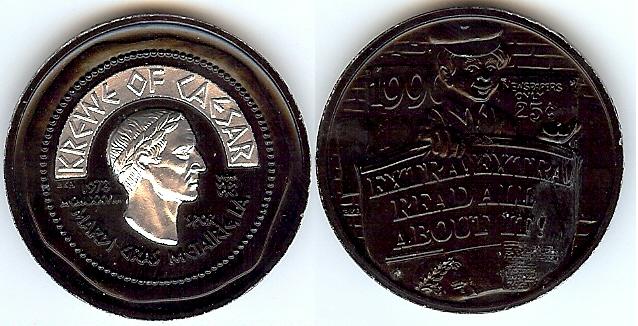
Krewe of Caesar 1990 dual silver on black
|
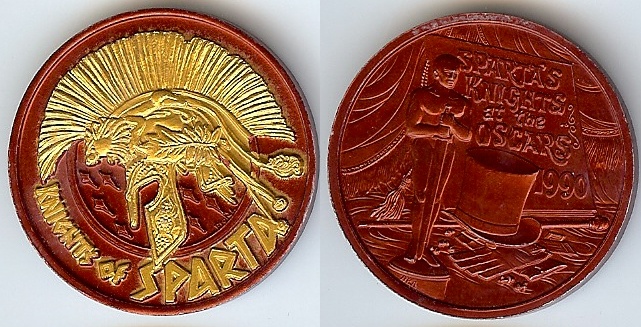
Krewe of Sparta 1990 dual gold on red
|
Duals - Advances in coloring technology and application produced the ability to have multiple colors on a single doubloon. There was an initial evolution of different ways to apply color to a doubloon, but the use of two colors on an aluminum base proved to be both affordable and popular, thus giving rise to their own group. Duals are usually of a thicker gauge and have a high-relief design. Krewes today no longer offer duals because modern doubloon manufactures have abandoned the practice as too costly and time-intensive.
|
|
Multi-color Cloisonne doubloons are another time-tested success story from the early evolution of color technology. A host of colors are typically painted on a thicker-gauge bronze base with a high-relief design and capped with a thick acrylic laminate. This can be done on both sides or just one side. Cloisonne doubloons (also commonly called "multis") remain popular today.
|
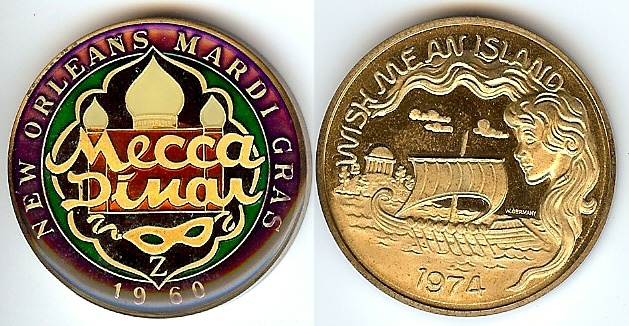
Krewe of Mecca 1974 multi
|
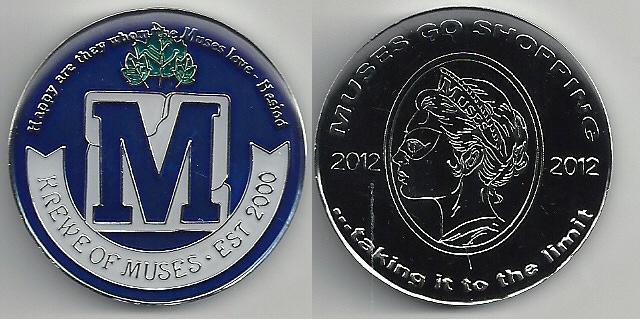
Krewe of Muses 2012 multi
|
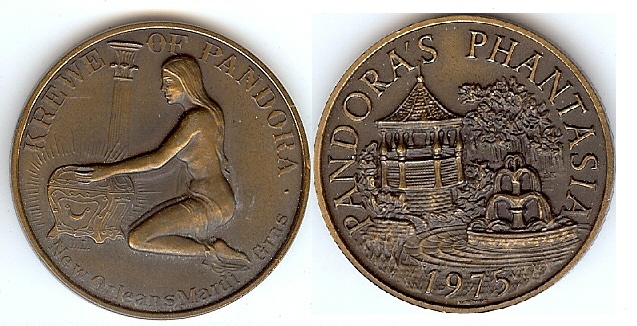
Krewe of Pandora 1975 antique bronze
|
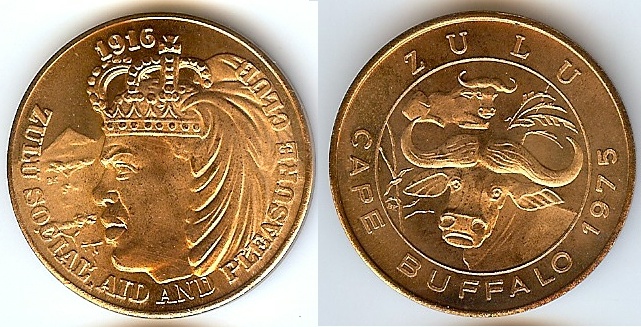
Krewe of Zulu 1975 copper
|
Heavies are doubloons made out of bronze, copper, silver oxide, nickel, sterling silver or other metals. They are generally of thicker gauge and often have a high-relief design and a patina applied (antiquing). And, of course, they are much heavier than aluminum. These are high-end doubloons, produced in lower quantity (some as low as just a few per year) and much more expensive than aluminum doubloons. As a high-end product, they tend to retain their value but don't show up in a lot of collections because of cost and limited availability.
|
There is another category of pseudo-doubloons or Non-doubloon Krewe Items which include badges, pins, stamps and cards. They are often included with doubloon collecting checklists to give a more complete picture of the krewe favors that can be collected in addition to doubloons. Other krewe throws like cups, beads and toys, though they do bear the krewe name, generally do not carry the theme or year and are made of materials that deteriorate with time. These have proven to be less attractive to collectors and are not included in checklists.
Identification ...
There are many, many features of a doubloon that can be varied to create a unique collectible item. Doubloon identification not only serves as a means of accurately describing a doubloon but also for distinguishing those sometimes subtle features that make one doubloon more desirable as a collectible than others.
Design - Doubloons have an obverse (front) and a reverse (back). The obverse typically has the krewe's emblem, name and year of origin and does not change much through time. The reverse will change every year and depicts the theme and the year. Lots of krewes also annually commemorate their royalty, officers, captain and/or special events with a different reverse design. These are often common throw doubloons but are more difficult to get because they are produced in smaller quantities and often only thrown by a single person or from a single float. Occasionally krewes will stamp doubloons without the krewe emblem but with some combination of what typically are designs occurring on the reverse of the doubloons for that particular year. Doubloons are also sometimes designed with one side totally blank (uniface) or with just a date. In the early years of doubloon production, many carnival and marching clubs would use the obverse for their name, theme and year and deploy a generic image for the reverse. This was a great money-saving feature because only one die had to be cut each year but it can be confusing to see the same design associated with a multitude of organizations.
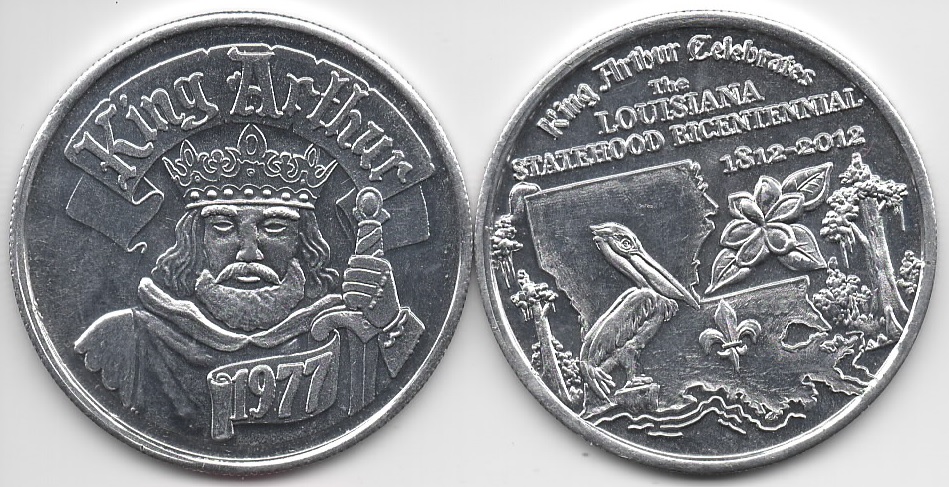
King Arthur 2012 (krewe emblem / theme)
|
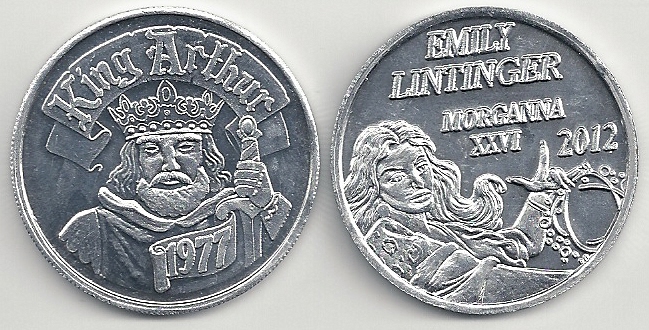
King Arthur 2012 (krewe emblem / Morganna)
|

King Arthur 2012 (Merlin / theme)
|
|
Base Material - Aluminum, wood, bronze, copper, silver oxide and sterling silver are the most common materials used to make doubloons, but also to a lesser extent brass, nickel, pewter, leather, plastic and gold / gold-plated.
|
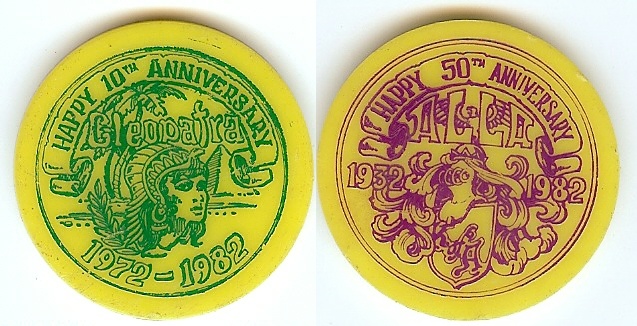
Cleopatra 1982 plastic
|
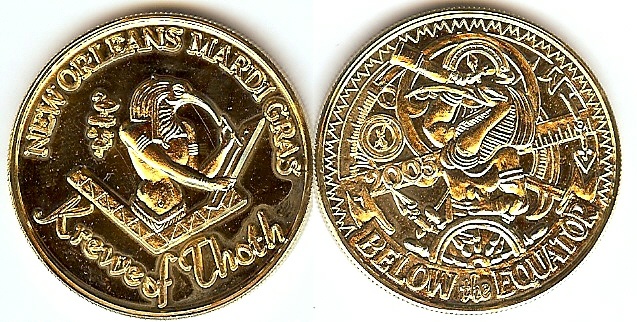
Krewe of Thoth 2005 gold-plated bronze
|
Color (Anodization) is attained by a two step process. First, the raw aluminum doubloon is sunk in an electrolytic solution which builds up an oxidized layer that is both resistant to corrosion and porous. Next, the pores are sealed either by immersion in water which produces no color, or dyeing which can produce an unlimited array of colors. The color holds well but doubloons can be scratched and dinged when thrown from floats and colors will fade if exposed to sunlight for a long time.
A great source of confusion in doubloon collecting is the use of metals as color names. An aluminum doubloon with no color shouldn't really be called "silver" because there are sterling silver doubloons and it shouldn't be called just "aluminum" because the colored ones are also aluminum. There have been a few doubloons made of actual gold but not enough that anyone would think you were talking about real gold when referring to a "gold-colored aluminum" doubloon. It's a little more tricky with "copper" and "pewter" because there are doubloons of both the color and the base metal. Some avoid the problem by always attaching the word aluminum to the back of the metal color, but really "pewter aluminum" is a rather clumsy oxymoron. Again there are no real guidelines so just be conscious of the issue and consistent in your usage. Most people just stick with what is simplest like plain, gold, copper-colored and grey.
Creating multiple colors on aluminum doubloons requires careful dyeing. First a base color is applied as described above. Then another color or colors are either painted or flooded onto the surface so as to fill around the high relief of the design. Anodized aluminum readily accepts the dyes and does not require any sealant. Bronze doubloons are also painted or flooded with dyes or paints but must have a thick acrylic coating applied to seal the colors to the bronze.
Some early examples of multi-coloring were done on aluminum or bronze and not capped with acrylic. Also for a few years, colored acrylic caps (some with multiple colors) were used rather than applying color to the doubloon. The terminology for these early experiments can be very confusing and inconsistent. Eventually duals (aluminum base) or multi-color cloisonne (bronze base with acrylilc cap) proved to be the most effective and popular application of multiple colors.
|
And, last but not least, is another color effect called brushed. A brushed doubloon has a dull, powdery-looking luster, which is especially effective on high-relief designs. Any color doubloon can be "brushed" and they are simply called brushed followed by the color, with brushed aluminum being used for those with no color. Brushed doubloons are no longer produced, however, the term is now being used for a modern version - plain aluminum doubloons which have a streaky black patina applied.
|
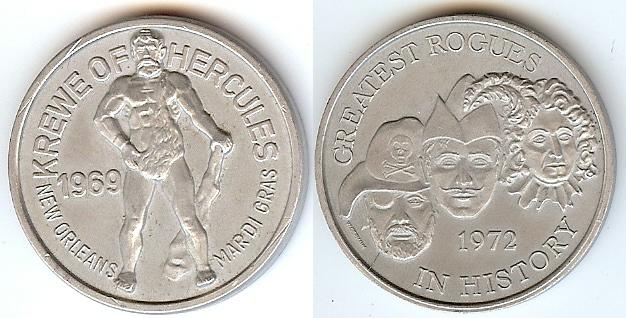
Krewe of Hercules 1972
brushed aluminum
|
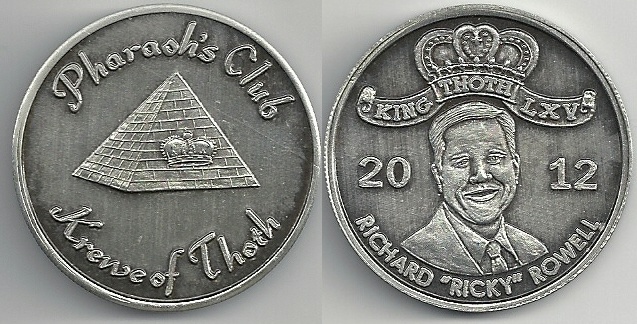
Krewe of Thoth 2012
"modern" brushed aluminum
|
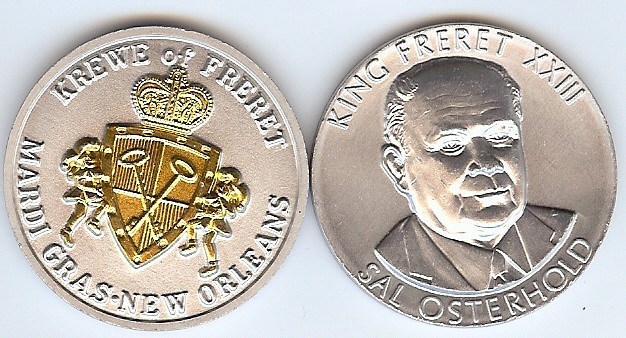
Krewe of Freret 1975 king dual
with extra high relief
|
High Relief - The depth and 3-dimensionality of surface designs is often exaggerated creating a high relief to the design. This not only looks more dramatic but also is effective for adding multiple colors and attaching well to an acrylic cap when creating duals or multis. Creating a high-relief design requires an entirely different die to be cut or an existing die to be incised even deeper after initial production of the common throw doubloons. There's always a greater expense involved so high relief doubloons tend to be limited to non-throw doubloons like special aluminum doubloons and heavies. There are some impressive examples of intense levels of relief and even three levels of relief being created for a single design .
|
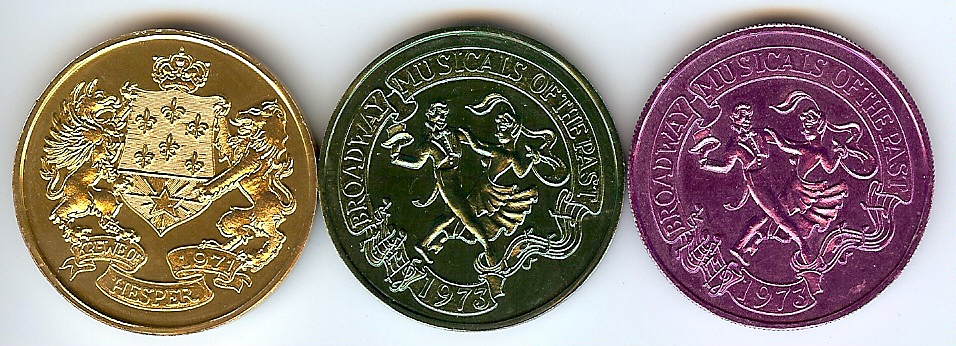
Krewe of Hesper 1973 low relief throw set
|
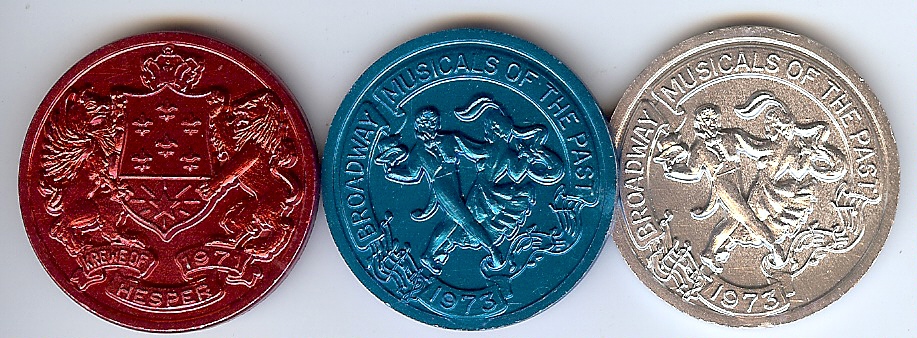
Krewe of Hesper 1973 high relief special aluminum set
|
|
|
Edge Effect- The most common edge effect is reeding in which the vertical edge of a doubloon is scored giving the effect of tightly spaced ridges. Doubloons with reeding are called "reeded edge", those without, "plain edge".
| ![]()
|
In more recent times, edge crimping has given rise to a whole new class of edge effects. Whereas reeding can only be detected by looking head on at the edge of a doubloon, crimping can also be seen along the perimeter of the flat surface of the doubloon. Terminology for crimped doubloons has been inconsistent. These are sometimes called by their order of repetition, i.e. hexagonal for a pattern of six crimps, which conflicts with doubloons that are actually cut in a hexagonal shape (see shape below). Classification of crimps is challenging because there can truly be any combination of number, size and arrangement of the crimps. For simplicity sake, using the term "crimped" is typically good enough to get the point across. For purposes of detailed description and those rare instances in which a krewe issues doubloons which are only differentiated by their crimping style, the following classification scheme is proposed.
scalloped
32 small, evenly-spaced crimps which are directly adjacent to each other
|
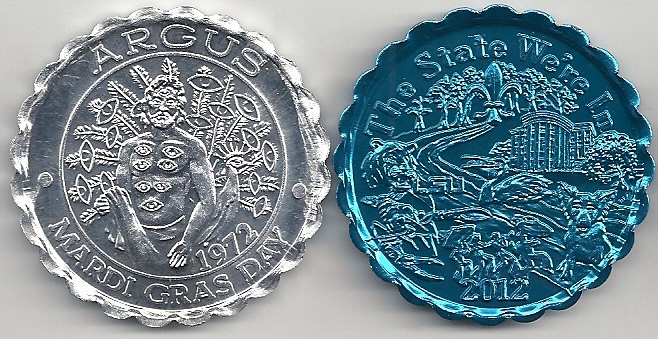
|
|
crimped 12L
12 large, evenly-spaced crimps
|
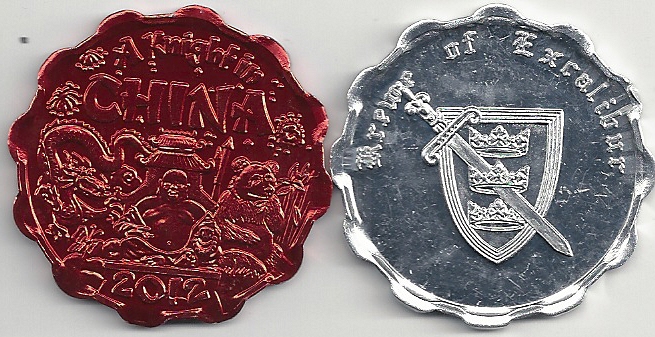
|
| crimped 12S
12 small, evenly-spaced crimps
|
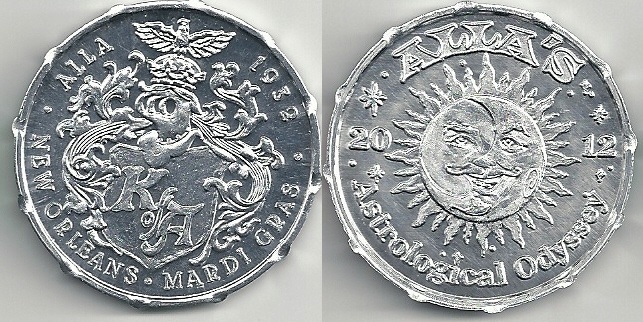
|
crimped 6L
6 large, evenly-spaced crimps
|
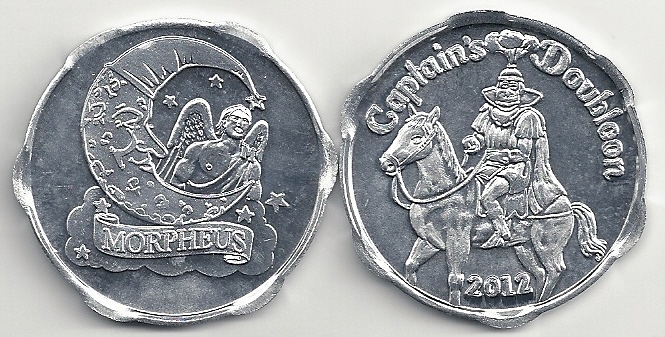
|
| crimped 6LU
6 large, unevenly-spaced crimps
|
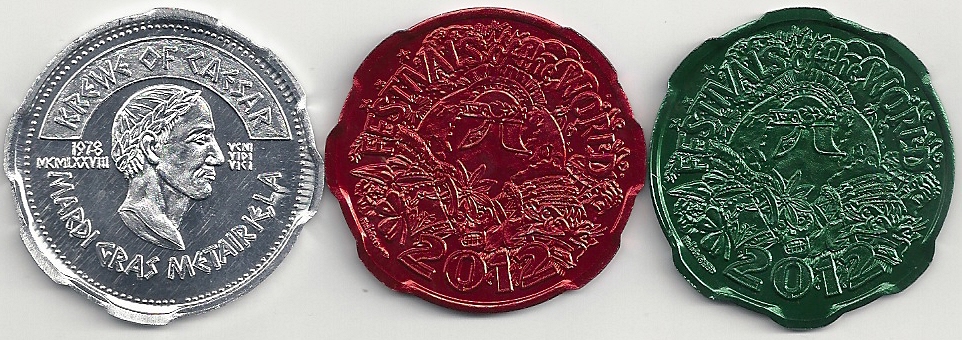
|
irregular
crimped but number, size and evenness are not distinguishable
|
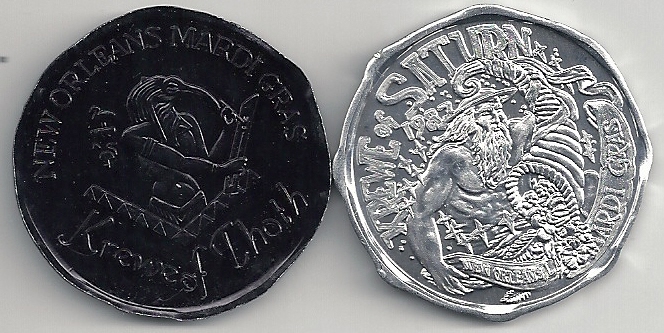
|
|
Here are some less common examples and their classifications.
crimped 4LU
4 large, unevenly-spaced crimps
|

|
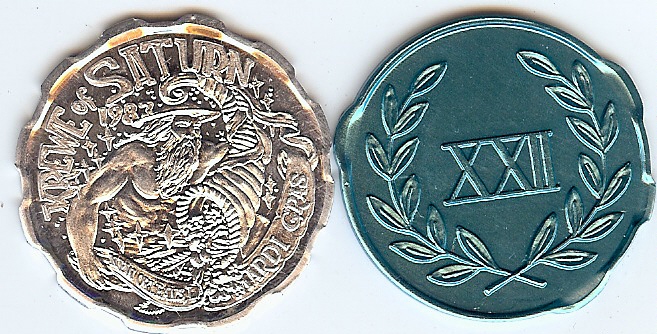
|
crimped 8L
8 large, evenly-spaced crimps
|
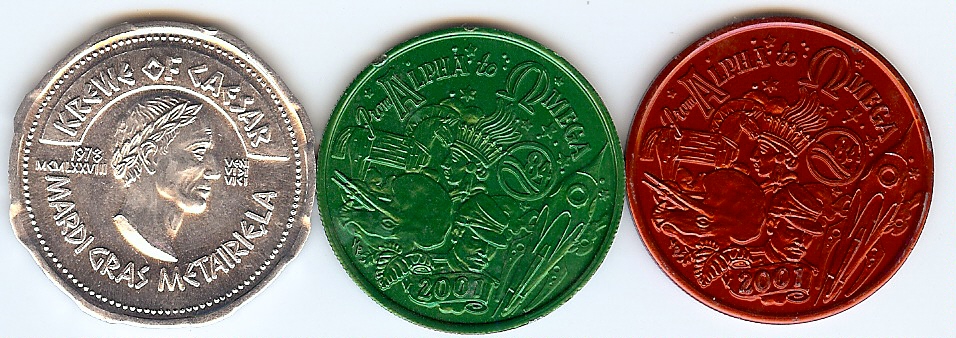
|
| crimped 12SU
12 small, unevenly-spaced crimps
|
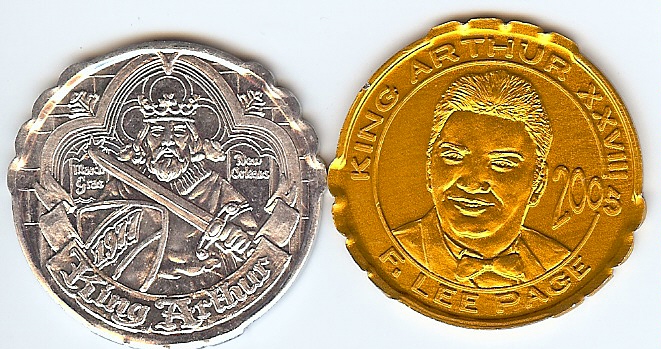
|
|
Thickness - The term actually used is Gauge which is borrowed from the measurment terminology used for the sheets of metal from which the doubloons are cut. Common throw doubloons are 15 gauge and most special doubloons are 10 gauge. Gauge is an inverse measurement system so 10 gauge is much thicker than 15 gauge. Also used less commonly are 12 gauge (somewhere in between 10 and 15) and 8 gauge (really thick).
| ![]()
|
Size - Doubloons are typically 1 3/4 inches in diameter, but from very early on in the history of Mardi Gras doubloons, variations in size have been used. At first this was a money-saving feature, as it was in an ill-fated attempt in 1979 to reduce the standard size to 1 inch. Some krewes also produced larger doubloons of 2 inches, which along with the smaller size of 3/4 inch, have regained popularity in recent times. Terminology for these is also poor with names like "mini" or "mini mini". And to add to the confusion, in 2008 Orpheus began throwing a 2 1/2 inch, 10 gauge doubloon, which looked more like a flying manhole cover. New dies must be cut for each change in doubloon diameter, making them more expensive and more likely to be in the special aluminum class rather than throw doubloons.
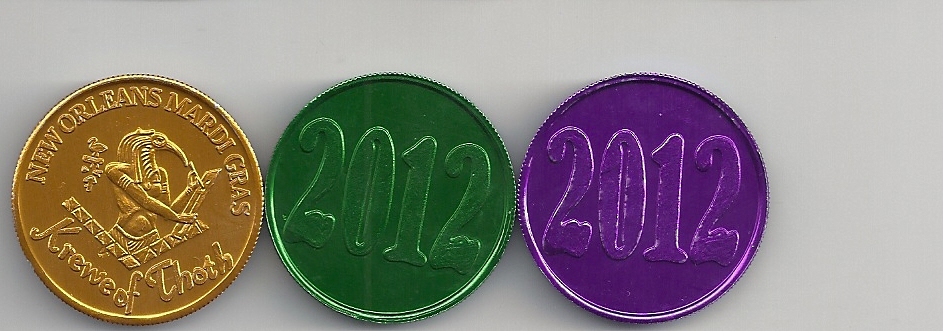
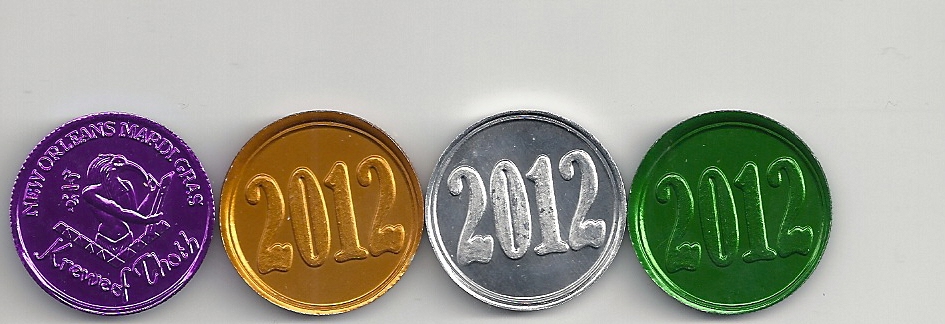
The Krewe of Thoth is infamous for producing a yearly array of smaller doubloons, some of which are available in very limited quantities from the riding lieutenants during the parades. Others are produced later in the season and distributed during the St Patrick's day parades. They are always a challenge for collectors but definitely some of the more sought after doubloons each year. |
Shape - Doubloons are predominately round except for the hexagonal doubloon which was used exclusively by the Krewe of Nefertari for both its throw and non-throw doubloons. Other less common, specially-shaped doubloons have always been popular as non-throw doubloons. I'm not sure you can even call these doubloons anymore. Some of the shapes that have been used are shields (Thor, King Arthur), hearts (Amor), apples (Eve), boxes (Pandora) and crowns (Mardi Gras). They can have any combination of other doubloon features making some rather dramatic in effect.
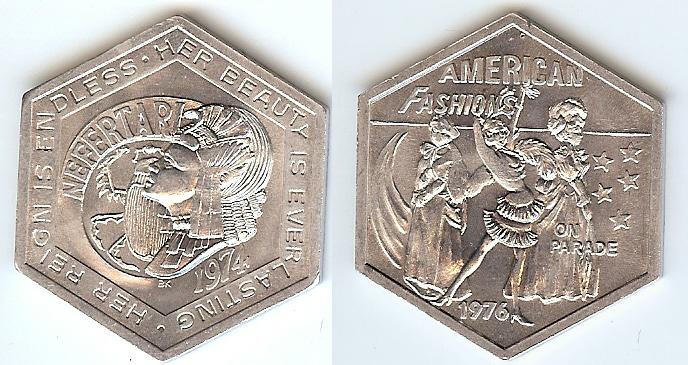
Krewe of Nefertari 1976 common throw doubloon
|
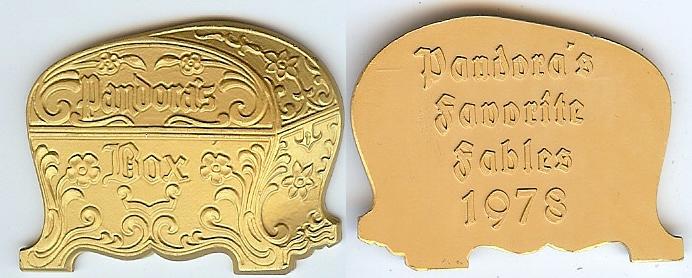
Krewe of Pandora 1978 brushed gold box
|
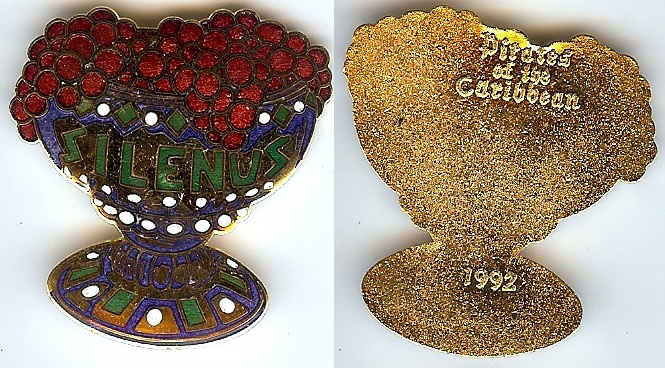
Krewe of Silenus 1992 multi cup
|
Varieties ...
Varieties are unintentional differences within any type of doubloon which occur during production. There is very little quality checking of the tens of thousands of doubloons that are produced each year for each krewe. The result is a multitude of slight differences that COULD make a doubloon more desirable as a collectible and possibly even more valuable. Varieties of doubloons can often be impossible to detect unless the doubloon can be compared to dozens of the same type. This causes problems for the collector because even if there is a description of a variety, often times it can't be determined unless the doubloons are set side by side. Also there are countless varieties that have never been described in any guide books, so every collector has to decide individually whether they want to ignore them or collect them. This lack of information and consensus can make collecting them very frustrating. Some choose to ignore them all together and just concentrate on what the krewe originally intended the type to be. Unfortunately many guide books are cluttered with poorly-described varieties making them hard to ignore (and to read!). In the end, there are few guidelines to help you with collecting varieties, so collect them as you will and don't be disappointed if others don't recognize or value them.
|
Color Variations - I would tend to believe that every color of throw doubloon has some examples of subtle color variation. They would all have to be dyed in the same exact batch to prevent it. Color variations can also be gradational which leads to the problem of uniquely identifying the shade. One commonly used nomenclature refers to "dark gold" doubloons as "orange". This bothers me because having two colors was surely not the intent of the krewe and there really are orange-colored doubloons which look nothing like the "dark gold" ones. It's probably best to stick with the original color and add another adjective to help describe the variation.
|
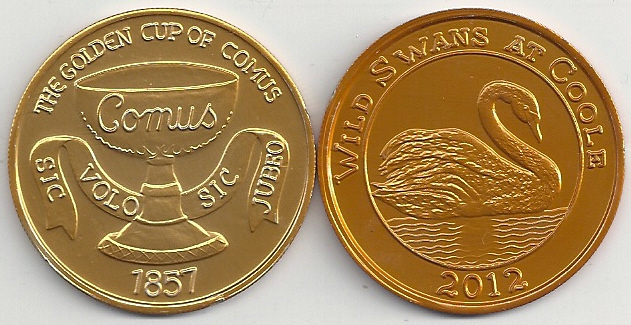
Comus 2012 light and dark gold
|
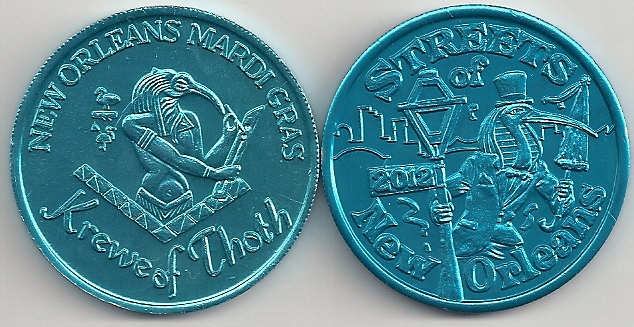
Krewe of Thoth 2012 light and dark turquoise
|
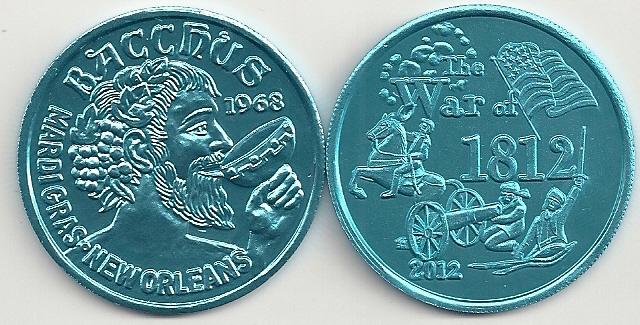
Bacchus 2012 shiny and dull turqouise
|
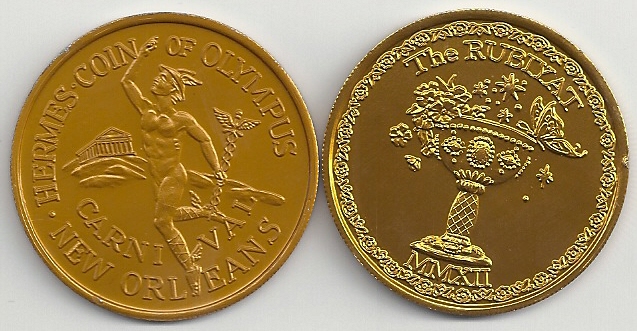
Hermes 2012 dull and shiny gold
|
Luster Variations - Sometimes doubloons can have a dull or a shiny finish. This, again, is probably due to some variation in the dye batch. And like subtle color variations, some can be very gradational and difficult to see.
|
|
Not Krewe Authorized (NKA) - This is a catch-all term for any doubloon which the krewe never had any intent of officially producing. Some unauthorized colors occur when a doubloon for one krewe is accidentally died in a color batch of another krewe's doubloons, and, sometimes doubloons destined to be colored never make it to the dye vat and remain plain. In other cases, doubloons are made by rouge krewe members who had access to the dies and could convince a manufacturer to produce them, or they simply created their own designs on wood doubloons. Many unintentional NKAs never get listed in doubloon guides unless enough of them surface in the collecting community.
|
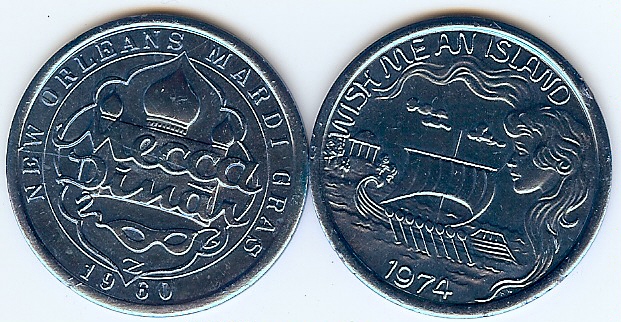
Krewe of Mecca 1974 NKA blue
an undocumented color
|
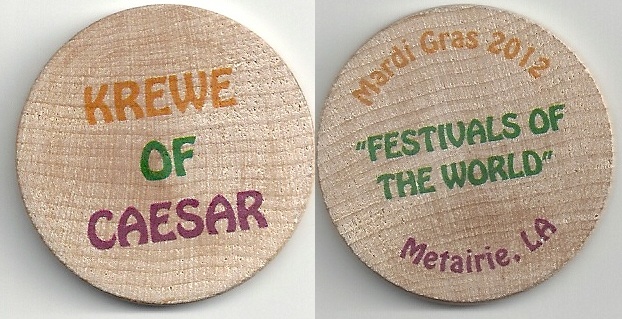
Krewe of Caesar 2012 NKA wood
a nicely-done rogue wood
|
Edge Effects - Traditionally edges were either plain or reeded and variations occur when one subset of a batch of doubloons scheduled to be reeded is not, or less rarely when the spacing on the reeding differs for that subset. The result is a group of oddballs mixed in with the normal ones. Since this is one of the more easily identifiable variations, they are typically very collectible and highly valued. Edge crimping also has the potential for variations if a batch are not crimped but this has never been recorded and probably is more easily controlled at the time of production. I haven't seen anyone yet create varieties based on the position of unevenly spaced crimps on a doubloon in relation to the design. Someone with a lot of time on their hands will come up with this one eventually.

Krewe of Cleopatra 1973 common throw doubloon
|
Die Position - Each doubloon has two dies cut - one for the obverse and one for the reverse. The dies are aligned at the time when the doubloons are pressed, but sometimes between pressings, the dies are inverted or set at an angle so that when the obverse design is held straight between two fingers and rotated, the reverse design is off from straight. This seems to have been more common in the 60's and early 70's, so perhaps this is one case where quality control has improved. Variations for straight, inverted and transverse have been documented but really there are just as many at odd angles which are either ignored or lumped in with the other positions.
|
Die Defects - These are the worse to try and detect. Die defects are cracks or pits that form in the die during pressing. They can be gradational as the die problem grows with each pressing. These are often impossible to detect to the untrained eye and require a large number of doubloons to verify. One of the more obvious types of die defects is known as clashing. Clashing occurs when the aluminum blank is inadvertently left out and the dies slam directly into each other causing damage to either or both of the dies. Every doubloon stamped after the "clash" will show the defect which usually appears as a smooth or smudged spot near the center of the design. Clashes can also be gradational if the manufacturer is particularly sloppy during the stamping process. Pitting is also another of the more obvious die defects. During pitting, some portion of the surface of the die fails (it looks like it actually melts out a hole) and results in a bubble or wart on the doubloon usually nearer the edge.
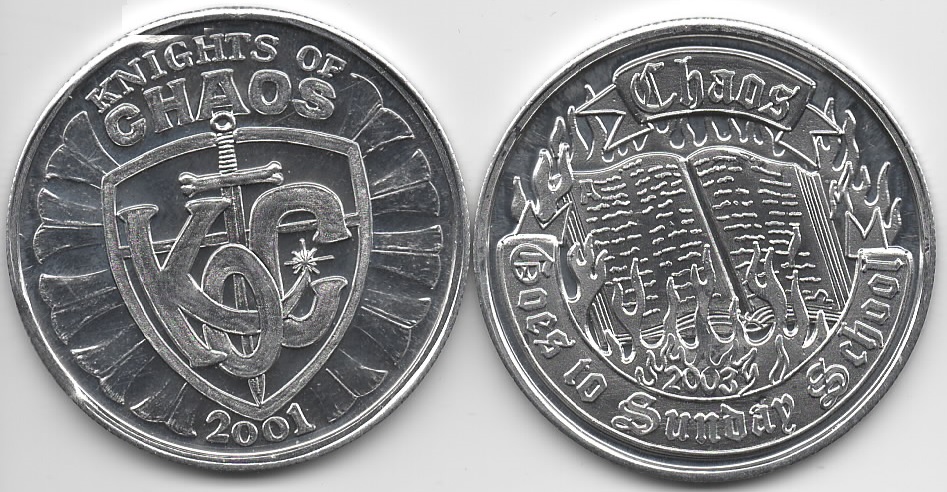
Krewe of Chaos 2003 common throw doubloon
with die pit
|

Comus 2009 common throw doubloon
with and without clashing
|
|
Die Changes - Die changes occur when a die fails before production of that years doubloons was complete. The cracks or pits have gotten so bad that the die had to be recut. An exact duplicate is nearly impossible, so there are usually some telltale signs in the design when a die is replaced during production. This more commonly happens with the krewe emblem die as these are reused from year to year. Die changes shouldn't be ignored because they are a true change in the design of the doubloon. However, because many of the differences are subtle and difficult to detect, and you need to be able to compare multiple doubloons to detect the change, many choose to ignore die changes altogether.
|
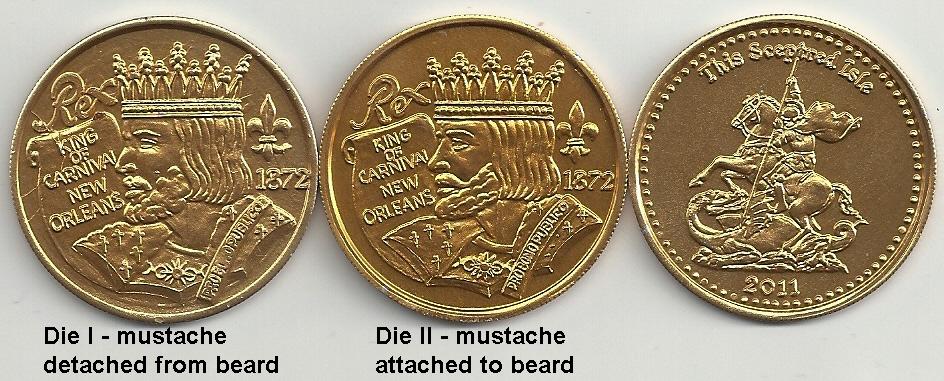
Krewe of Rex 2011 obverse die change
|
Thickness Variations - The difference between 8 and 10 gauge, and, 12 and 15 gauge is subtle but distinguishable. These are often cases where the manufacturer did not notice the subtle difference as the initial round blanks were being cut from the sheet metal. Sometimes thickness variations can simply be attributed to uneven rim height.
Fakes - Doubloons, in general, are not worth enough to justify the cost and effort of making a near perfect replica, however, the 1970 re-issue of the original 1960 Rex design is troublesome. Troublesome because the original gold 1960 Rex can easily fetch $100 or more. The differences are subtle enough that unscrupulous sellers can just claim they couldn't tell. If in doubt, get a second opinion. Most avid collectors and dealers can tell the difference from just a photo or a scan of the doubloon in question.
Almost as soon as doubloons began to be anodized, someone figured out that boiling doubloons removed the organic dyes used to color them. This also has been a significant problem with early Rex doubloons. From 1962 through 1974, Rex issued a plain aluminum doubloon in limited quantites along with its regular gold-colored aluminum throw doubloon. Some can fetch more than $300. Treating doubloons to remove color does leave clues. These doubloon will appear to be dyed silver and not have the dull luster of a plain aluminum surface. The best way to tell, however, is just to try and bend them. Boiling the doubloons weakens the aluminum significantly and they can be bent with just bare fingers. Unfortunately to do both of these tests you need the doubloon in hand (and a seller willing to let you potentially maul his doubloon). A photo or scan just won't do.
Value ...
So what are doubloons worth? Most people who want to know what a collection is worth have probably just inherited a relative's moldy binders and cluttered boxes from the 80's. And, they wrongly associate quantity and age with the value they conjure up for the collection. But, both of these assumptions are basically wrong. Unsorted boxes of doubloons have little value mostly because they require too much work to sort through. The best you can hope to get is the base metal price of scrap aluminum, even if there could be some treasures buried in the box. Typically that is about 50 cents to $1 per pound or half a cent to 1 cent each. Ironically, it costs much more to produce doubloons and krewe members pay much more than that to have them as one of their throw options. There simply is not enough collector interest to drive the price any higher than that.
Collections already sorted and in binders will fetch a better price because the buyer can more easily evaluate them.
Still the sorted collection will be split mostly by base metal content and value will only be placed on non-aluminum doubloons and the better classes of aluminum doubloons. The only doubloons which typically fetch a higher value are pure silver and multi-colored cloisonne (bronze metal base) doubloons. As you can imagine, these rarely find their way into common collections. If you have binders of just common throw doubloons, then you won't get much better than scrap value. Better classes of aluminum doubloons will rarely fetch more than 25 cents each. An honest buyer will pay you properly for really rare doubloons but even these can easily be overlooked during an evaluation. If you really feel that you may have some treasures, invest in a doubloon price guide and go into a collection evaluation armed with some knowledge of an approximate value of your collection.
Doubloons sold individually are usually priced at book value or higher because the seller has invested a lot of effort into indivudally identifying and marketing the doubloon. The market for individually sold doubloons will be very limited as most collectors are only interested in what they don't yet have and with prices that high, they tend to be inclined to trade rather than buy. Many individually sold doubloons are marketed by theme content to attract buyers from other genres of collecting who are more willing to pay for what they consider to be an oddity. Current year doubloons are the exception, however. They often fetch book value or better because the competition to get the latest and greatest is always high at the time a season's doubloons first come on the market.
Resources ....
Thanks for taking the time to read my page (and my opinions!). I hope it has been informative and you are encouraged to explore your interest more deeply. Listed below are some great ways to keep current with the hobby of doubloon collecting.
Crescent City Doubloon Traders - swap locations and info on membership and the CCDT doubloon checklist
Mardi Gras Doubloons Yahoo Group - free chat group managed by Bobby Vallecillo
E-Bay - search on "doubloons mardi gras" for what's available (typically high-end prices)
MardiGrasDoubloons.com - Rafael Monzon's on-line doubloon shop and doubloon info hub. Rafael buys and appraises collections.
Collectorsphere - maintain your doubloon inventory free at this website managed by Bill Plunkett
Mardi Gras Doubloons - Facebook group maintained by Ryan Soudelier
Chris' Fine Jewelry, 3304 West Eslanade Av, Metairie, La - limited supply of sorted doubloons (not on display) and unsorted, unpriced doubloons in binders and boxes. Chris' will buy doubloons in bulk.
Doubloons Unlimited Inc, 3005 David Dr, Metairie, La run by Joe & Pat Albert. Open on Saturdays for a few months following Mardi Gras - call ahead to be sure (504) 456-1193. Freestanding and wall hung display cases feature thousands of doubloons (with prices) for sale arranged by krewe. The past few years' doubloons are displayed in special cases near the front door.









































